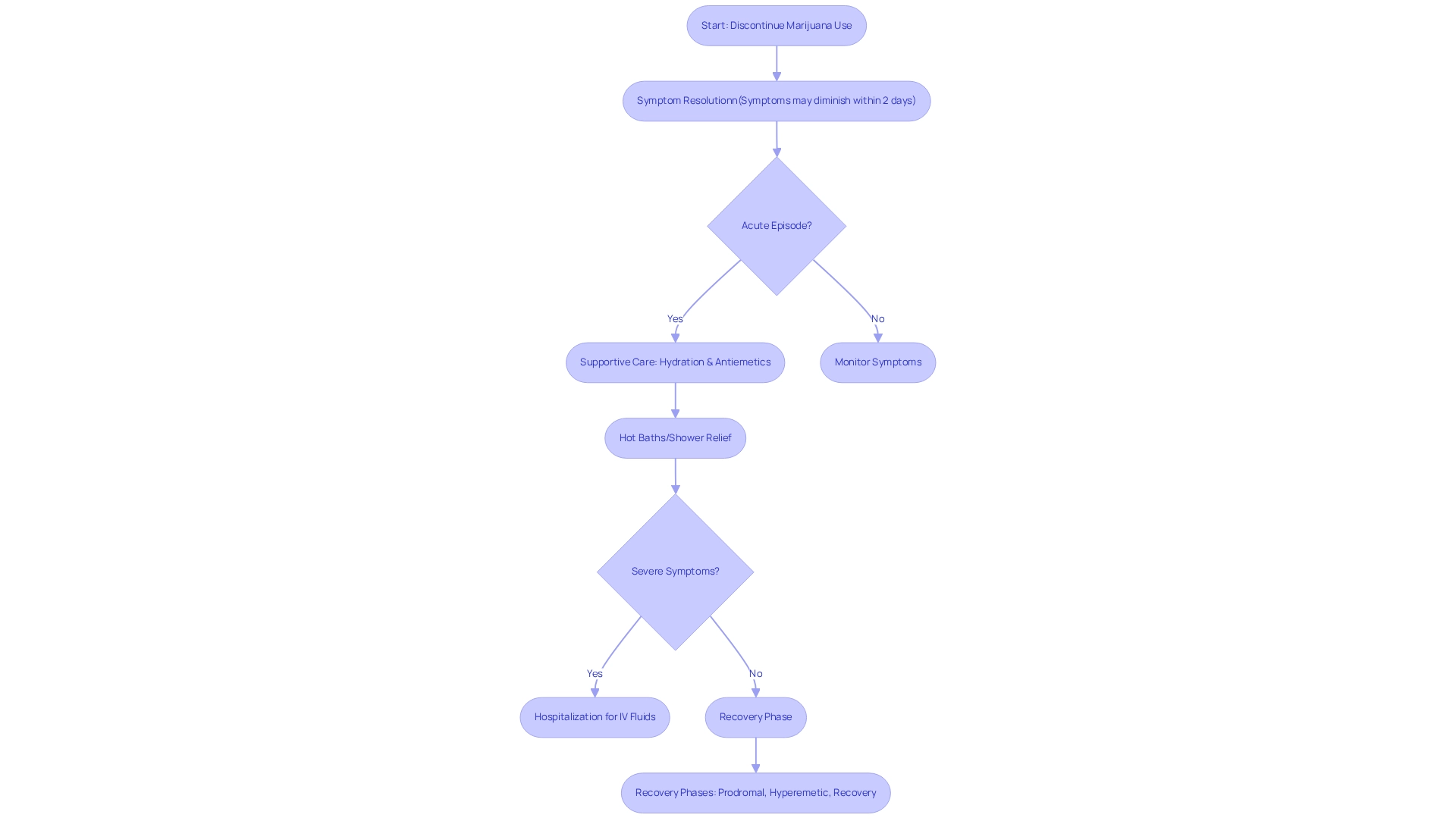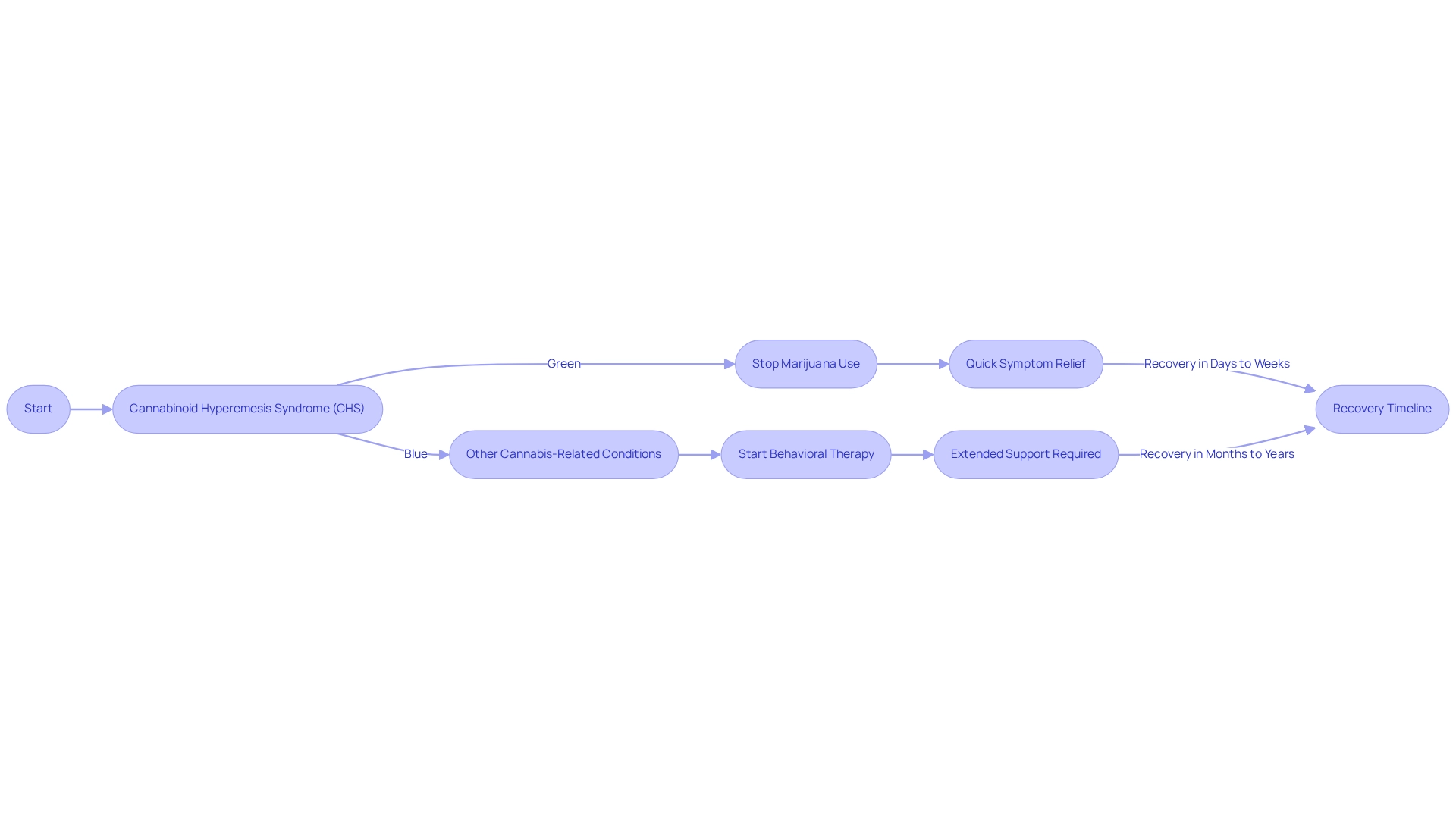Overview
Recovering from Cannabinoid Hyperemesis Syndrome (CHS) can be a challenging journey, but understanding the timeline can provide some comfort. Typically, recovery takes a few days to several weeks after stopping marijuana use. This is quite different from other cannabis-related conditions, such as substance use disorder, which may require months or even years for recovery.
This distinction is significant. The symptoms of CHS often improve rapidly once marijuana use ceases, underscoring the importance of immediate supportive care. Have you or someone you know faced similar challenges? It’s crucial to recognize that stopping marijuana use is a vital step towards recovery. Together, we can navigate this path and explore supportive resources that can aid in healing.
Introduction
In the evolving landscape of cannabis consumption, Cannabinoid Hyperemesis Syndrome (CHS) has emerged as a significant public health concern, particularly among chronic users. This complex condition, characterized by severe nausea, vomiting, and abdominal pain, can often go misdiagnosed due to its overlapping symptoms with other gastrointestinal disorders.
Have you or someone you know experienced these troubling symptoms? As the prevalence of CHS rises, especially among younger demographics, understanding its causes, symptoms, and treatment options becomes increasingly critical.
This article delves into the intricacies of CHS, offering insights into its diagnosis and management. Together, we can highlight the vital role of education in preventing its onset and emphasize the importance of informed decision-making in cannabis use.
Let’s explore this important topic together.
Understanding Cannabinoid Hyperemesis Syndrome: An Overview
Cannabinoid Hyperemesis Syndrome (CHS) is a complex condition that can bring about intense nausea, vomiting, and abdominal discomfort. This syndrome primarily affects individuals who have regularly consumed marijuana over a long period. Recent statistics indicate that CHS can occur in as many as 6 per 1,000 long-term marijuana users aged 16-24, underscoring its growing significance as a public health concern.
Many people may not recognize CHS due to its similarities with other gastrointestinal disorders, making awareness and understanding essential for effective treatment. A unique aspect of CHS is that individuals often find temporary relief from their discomfort by taking hot showers or baths, a behavior that has become a defining feature of this condition.
As the number of CHS cases appears to be rising, especially in North America, it is increasingly common in emergency departments. This trend highlights the urgent need for further research and preventative education. Healthcare providers emphasize the importance of treating the whole person rather than just the symptoms, as the stigma surrounding marijuana use can complicate both diagnosis and treatment.
Understanding the recovery timeline from Cannabinoid Hyperemesis Syndrome is crucial. It not only helps recognize the impact on health but also highlights the need to stop marijuana use for recovery. This condition serves as a reminder of the complexities associated with marijuana consumption and the importance of making informed decisions in today’s evolving landscape.
At Leafy Mate, we strive to be a supportive resource in navigating these complexities. We connect users with trusted medical marijuana physicians and high-quality marijuana brands. Together, we empower consumers by providing educational resources and guidance to make informed choices about their marijuana use.
To learn more about how Leafy Mate can assist you, we invite you to visit our website and explore our offerings.
What Causes Cannabinoid Hyperemesis Syndrome?
The exact cause of Cannabinoid Hyperemesis Syndrome (CHS) remains unclear, yet it is becoming increasingly linked to long-term marijuana use, particularly with high-THC varieties. Research indicates that prolonged exposure to cannabinoids may disrupt the endocannabinoid system, leading to significant gastrointestinal disturbances. This dysregulation can manifest as severe nausea and vomiting, symptoms often misattributed to other conditions.
In 2013, an estimated 181.8 million people aged 15-64 years used marijuana globally, highlighting the prevalence of its use and its potential link to CHS. As we navigate this complex landscape, understanding CHS is crucial, but it is equally important to recognize the medical advantages of marijuana. For instance, medical marijuana has been shown to reduce seizures in children with severe epilepsy by up to 50%, offering hope to families seeking effective treatment options. Additionally, marijuana has been found to alleviate symptoms of chronic pain, multiple sclerosis, and nausea associated with chemotherapy.
This natural remedy provides a safer and more holistic approach to healthcare, allowing individuals to find relief without relying on potentially addictive prescription drugs, which often come with harmful side effects. Have you considered how genetic factors and individual differences in cannabinoid metabolism might contribute to the development of CHS? For example, some individuals may have genetic tendencies that render them more prone to the negative effects of marijuana. Understanding how long it takes to recover from cannabinoid hyperemesis syndrome and its underlying causes is essential for both patients and healthcare providers, as this knowledge can inform more effective management and prevention strategies.
Recent case studies have shown that certain genetic markers may correlate with increased vulnerability to CHS, emphasizing the need for personalized approaches in treatment. Recent studies highlight the significance of acknowledging the risks linked to long-term marijuana use. Significantly, research from Yale Medicine is investigating innovative treatments for marijuana use disorder, which may offer insights into managing conditions like CHS. Their findings suggest that enhancing the brain’s cannabis-like proteins could be a promising avenue for treatment, potentially alleviating withdrawal symptoms and reducing overall drug use.
As Andrew Meltzer, a Professor of Emergency Medicine, states, “Physicians should explain that and advise patients on resources to help them quit.” As the marijuana landscape evolves, it is crucial for healthcare professionals to stay informed about the latest research and treatment options. This knowledge not only assists in the effective management of CHS but also empowers patients to make informed choices regarding their use of marijuana, balancing the potential benefits with the risks. The legalization of medical cannabis not only provides hope for those who are suffering but also empowers individuals to take control of their own healthcare, allowing them to explore alternative treatment options that may have been previously inaccessible.
Recognizing the Symptoms of Cannabinoid Hyperemesis Syndrome
Cannabinoid Hyperemesis Syndrome (CHS) presents a unique set of symptoms that can be quite distressing. These include intense nausea, frequent vomiting, abdominal discomfort, and an unusual urge to bathe. Patients often experience these symptoms in cycles, with periods of relief followed by intense flare-ups. The severity of vomiting can lead to dehydration and electrolyte imbalances, which may necessitate urgent medical care.
Recent studies reveal a concerning trend among marijuana users, highlighting a significant prevalence of nausea and vomiting. A retrospective observational cohort study found that the annual incidence of suspected CHS increased by approximately 134–175% over an 11-year period in Northern California. This alarming statistic underscores the importance of recognizing the signs of CHS quickly. As gastroenterologist Christopher Andrews points out, “I would suspect the policy-makers probably wouldn’t move to ban any kind of flower you can grow,” reflecting the ongoing discussions surrounding cannabis use and its effects.
Recognizing the signs of CHS early is crucial for effective management and understanding recovery timelines. If you or someone you know is experiencing these symptoms, it’s vital to seek medical advice, especially if signs of dehydration are present. Look out for symptoms like:
- Dark urine
- Confusion
- Dizziness
- Fatigue
- Rapid heart rate
- Fainting
Emergency medical assistance is recommended for these signs of dehydration. Remember, prompt intervention can significantly improve outcomes for those affected by this condition, and together, we can navigate this challenging experience.
Diagnosing Cannabinoid Hyperemesis Syndrome: Key Considerations
Diagnosing Cannabinoid Hyperemesis Syndrome (CHS) requires a compassionate and thorough approach. It’s essential to gather a detailed medical history, particularly focusing on the frequency and duration of marijuana use. A comprehensive physical examination is also crucial to rule out other gastrointestinal disorders. The Rome IV criteria for cyclic vomiting syndrome are particularly relevant here, as CHS shares overlapping symptoms. Accurate diagnosis is vital; misdiagnosis can lead to inappropriate treatments, worsening the patient’s condition and prolonging suffering. Alarmingly, statistics indicate that misdiagnosis rates for CHS can be as high as 30%, with many patients initially misidentified with other gastrointestinal issues.
This highlights the importance for healthcare providers to carefully assess the patient’s marijuana use history and symptomatology. For example, a case study on the hyperemesis phase of CHS showed that patients often endure severe nausea and frequent vomiting, prompting multiple emergency room visits. While many eventually return to normal eating patterns, the risk of relapse remains if marijuana use continues.
Experts emphasize the need to recognize the unique manifestations of CHS. Dr. Trope, a pediatric hospitalist at Santa Clara Valley Medical Center, urges healthcare professionals to remain vigilant and consider CHS in patients exhibiting cyclic vomiting, especially those with a known history of marijuana use. Current best practices advocate for a multidisciplinary approach, integrating insights from gastroenterology and addiction medicine to foster a holistic understanding of the patient’s condition.
Moreover, recent findings suggest that the sympathetic nervous system may play a role in CHS, with symptoms like rapid heartbeat and sweating appearing during hyperemesis phases.
By adhering to these guidelines, healthcare providers can improve diagnostic accuracy and patient outcomes in cases of Cannabinoid Hyperemesis Syndrome. Additionally, using topical capsaicin cream at concentrations of 0.025% to 0.15% has been shown to significantly reduce emergency department stay from an average of 7.09 hours to 4.83 hours. This underscores the importance of effective treatment options and their positive implications for patient care.
Treatment Approaches for Cannabinoid Hyperemesis Syndrome
Managing Cannabinoid Hyperemesis Syndrome (CHS) begins with the compassionate step of completely discontinuing marijuana use. For many individuals, this crucial action leads to a significant resolution of their symptoms. Research indicates that signs often diminish within just two days after stopping marijuana consumption, although some effects may linger for several weeks. During acute episodes, supportive care is essential, typically involving hydration and antiemetic medications to effectively manage nausea and vomiting.
Many patients find temporary relief through soothing hot baths or showers, which can ease discomfort. In more severe cases, hospitalization may be required to provide intravenous fluids and close monitoring, ensuring that individuals receive the care they need.
CHS is characterized by three distinct phases:
- Prodromal
- Hyperemetic
- Recovery
Understanding these phases is vital for effective management and for recognizing the recovery timeline from cannabinoid hyperemesis syndrome. Real-world examples show that individuals who follow these guidelines often experience significant improvements in their health and well-being.
Moreover, experts emphasize the importance of stopping marijuana use, not just for recovery but also to prevent symptoms from recurring, which can happen if marijuana is resumed. The success rates for treating CHS are notably high when patients commit to discontinuing marijuana. This raises the important question: how long does it take to recover from cannabinoid hyperemesis syndrome? This highlights the critical nature of this approach in the recovery process. Additionally, it’s important to clarify that THC is the chemical responsible for CHS, while CBD does not cause this condition, helping to dispel common misconceptions about marijuana use.
At Leafy Mate, we prioritize education and accessibility to empower users with the knowledge they need to navigate the complexities of cannabis-related health issues. Through our platform, we connect users to reliable medical marijuana physicians and quality marijuana brands, ensuring that new users have the support and information necessary for a safe and enjoyable experience. We facilitate these connections by offering a curated list of high-quality marijuana brands and experienced medical marijuana doctors, ensuring users receive the best possible care and products.
As Angela N. from addiction help.com states, “addiction help.com is helping to make recovery available to EVERYONE!” Together, we can navigate this journey towards better health.
Comparative Recovery Times: CHS vs. Other Cannabis-Related Conditions
Many individuals often wonder about the recovery timeline for cannabinoid hyperemesis syndrome (CHS). Recovery times can vary widely, typically ranging from a few days to several weeks after stopping the use of marijuana. This rapid improvement stands in contrast to recovery from other marijuana-related conditions, such as substance use disorder. In these cases, longer-term behavioral therapies and support systems may be necessary. Indeed, recovery from marijuana use disorder can last for months or even years, highlighting the complexity of treatment and the need for ongoing support.
One defining feature of CHS is the quick alleviation of symptoms upon ceasing marijuana use. This leads to questions about how recovery from CHS compares to other marijuana-related health issues. Research indicates that the length of marijuana use before the onset of CHS symptoms can vary from six months to eleven years, underscoring the extended exposure that may contribute to the syndrome’s progression. While there is currently no substantial evidence supporting medical treatments for marijuana withdrawal, professional opinions emphasize that supportive care remains a crucial aspect of recovery approaches.
This focus on support is particularly important given the common withdrawal effects experienced by frequent marijuana users. Studies suggest that women may face more intense withdrawal effects, adding another layer of complexity to their recovery journey.
Practical examples illustrate the differences in recovery timelines. For instance, consider the recent case of a 46-year-old woman who presented to the emergency department with withdrawal signs after losing her job and being unable to afford medical marijuana. This situation highlights the urgent need for effective support systems for individuals facing the complexities of cannabis-related health issues. It directly relates to how long it takes to recover from cannabinoid hyperemesis syndrome and the challenges faced during withdrawal.
In summary, while recovery from CHS can often be relatively swift, it is essential to recognize the broader context of cannabis-related conditions. Recovery from these conditions may require more extensive interventions and support. As Jeremy Hernandez noted in his study on CHS presentation, understanding these dynamics is crucial for developing effective treatment and support strategies. Together, we can foster a supportive environment for those navigating these challenges.
Health Consequences of Cannabinoid Hyperemesis Syndrome
Cannabinoid Hyperemesis Syndrome (CHS) poses significant health risks that we must address together. It is primarily characterized by severe dehydration and electrolyte imbalances resulting from persistent vomiting. Over the last decade, the strength of THC has surged, increasing tenfold, which has led to a concerning rise in CHS cases among frequent marijuana users. If left untreated, this condition can lead to serious complications, including potential kidney damage.
Moreover, the psychological toll of chronic nausea and vomiting can intensify mental health issues, contributing to anxiety and depression for those affected. Have you or someone you know experienced these challenges?
Recent studies underscore the critical need for early diagnosis and intervention. For instance, new diagnostic criteria for CHS now include a weight loss of 5 kg or more, with symptoms often peaking in the morning while bowel habits remain normal. Unfortunately, laboratory tests typically yield negative results, complicating the diagnosis process.
Effective management strategies highlight the importance of ceasing cannabis use, staying hydrated, and receiving supportive care. It’s essential to understand that traditional antiemetics have proven largely ineffective in treating CHS. A case study titled ‘Cannabinoid Hyperemesis Syndrome: An Update for Primary Care Providers’ emphasizes the importance of awareness among healthcare professionals regarding CHS indications and management strategies.
Real-world examples illustrate the severity of dehydration and electrolyte imbalances in CHS patients, reminding us of the importance of awareness among healthcare providers. By recognizing the symptoms and health consequences associated with CHS, medical professionals can help prevent unnecessary emergency visits and hospitalizations, ultimately improving patient outcomes. Ongoing studies are examining the long-term impacts of CHS, reinforcing the need for informed decision-making and education within the marijuana community.
At Leafy Mate, we are dedicated to creating a community of informed consumers through education and resource accessibility. Together, we can ensure that individuals are equipped with the necessary knowledge to navigate the complexities of marijuana use.
Preventing Cannabinoid Hyperemesis Syndrome: What You Need to Know
Preventing Cannabinoid Hyperemesis Syndrome (CHS) requires careful moderation of marijuana use, especially with high-THC products. If you have a history of cyclic vomiting or gastrointestinal disorders, it’s important to exercise heightened caution. At Leafy Mate, we understand that education is key to prevention. Knowing the health risks associated with chronic marijuana use is essential for everyone.
We provide resources that connect you with reliable medical marijuana physicians and premium brands, offering guidance tailored to your needs. Research shows that completely stopping marijuana is the only proven way to prevent CHS from recurring for those who have experienced it. This information is crucial for individuals who wish to use marijuana responsibly while protecting their health.
While marijuana has significant analgesic effects, statistics reveal that these do not surpass those of conventional medications like codeine, underscoring the need for moderation. Additionally, findings from the BART model and Harborview Medical Center confirm a link between long-term marijuana use and an increased risk of postoperative nausea and vomiting (PONV). Experts advise that chronic marijuana users should be aware of their heightened risk for PONV, emphasizing the importance of making informed decisions about marijuana use.
As Joseph Porta-Sales noted, “We believe that it will be beneficial to examine the scientific validity for the new assertions regarding the medical application of marijuana.”
Case studies have shown a clear connection between chronic marijuana use and an increased risk of PONV, leading to recommendations for caution in adjusting prophylactic measures for these individuals. As the marijuana landscape evolves, ongoing education about its health implications is critical in preventing CHS and promoting safer consumption practices. At Leafy Mate, we are dedicated to empowering you with the knowledge needed to navigate this complex landscape responsibly.
We invite you to explore our guides and connect with medical marijuana doctors through Leafy Mate for personalized support. Together, we can ensure that your choices are informed and health-conscious.
Getting Help: Resources for Cannabis-Related Conditions
For individuals grappling with Cannabinoid Hyperemesis Syndrome (CHS) or other cannabis-related health conditions, seeking professional assistance is crucial. At Leafy Mate, we connect you with a diverse selection of high-quality, reputable marijuana brands and medical marijuana physicians throughout North America, ensuring access to the finest resources available. We are dedicated to offering educational resources that outline the health effects of marijuana, which can be essential in understanding your condition and its management.
Additionally, we provide resources that assist new users in making informed decisions about their usage. Have you considered how support groups can aid recovery for CHS patients? Research indicates that participation in these groups can significantly enhance emotional support and provide practical coping strategies. For instance, a case study highlighted the positive outcomes of a local support group, where participants reported reduced challenges and improved well-being through shared experiences and mutual guidance.
Organizations focused on marijuana health offer counseling and rehabilitation services specifically designed for marijuana users. These services not only address the urgent signs of CHS but also help individuals navigate the complexities of marijuana use and its related health risks. Accessing these resources through Leafy Mate can be a pivotal step toward recovery, empowering you to learn how long it takes to recover from cannabinoid hyperemesis syndrome and regain control over your health and well-being.
As Matt Gonzales wisely states, “Don’t wait—reach out today to take the first step toward taking control of your life.”
Moreover, gradually reducing marijuana use is often recommended to ease withdrawal discomfort and prevent relapse. This approach aligns with findings that acute intoxication typically resolves without the need for medical intervention, underscoring the importance of a supportive environment during recovery. By leveraging available resources and professional help through Leafy Mate, you can effectively manage your symptoms and work towards a healthier future.
Furthermore, understanding societal attitudes towards cannabis, such as the 26% of individuals who oppose its legalization, can provide context for those seeking help for cannabis-related conditions. Together, we can navigate this journey toward better health and well-being.
Conclusion
Understanding Cannabinoid Hyperemesis Syndrome (CHS) is crucial as cannabis use continues to rise, especially among younger individuals. This complex condition, characterized by severe nausea, vomiting, and abdominal pain, often goes misdiagnosed due to its similarity to other gastrointestinal disorders. Recognizing CHS symptoms and seeking timely medical advice is vital, as early intervention can significantly enhance patient outcomes.
The key to effective management is the complete cessation of cannabis use, which usually leads to a quick resolution of symptoms. Supportive care, such as hydration and antiemetic medications, is essential during acute episodes. Research highlights the importance of understanding the risks associated with chronic cannabis use, particularly with high-THC strains. This knowledge empowers both patients and healthcare providers to make informed decisions that can prevent CHS and its complications.
Furthermore, the psychological and physical health impacts of CHS underscore the need for awareness and education within the cannabis community. Organizations like Leafy Mate are committed to equipping users with the resources and connections to trusted medical professionals. Together, we can navigate the complexities of cannabis use safely and responsibly. By fostering a community of informed consumers, we can significantly reduce the potential for CHS and its repercussions, paving the way for healthier cannabis consumption practices.
Have you considered how your cannabis use might affect your health? Let’s work together to ensure that our choices lead to well-being and safety for everyone.
Frequently Asked Questions
What is Cannabinoid Hyperemesis Syndrome (CHS)?
CHS is a complex condition characterized by intense nausea, vomiting, and abdominal discomfort, primarily affecting individuals who have regularly consumed marijuana over a long period.
How common is CHS among marijuana users?
Recent statistics indicate that CHS can occur in as many as 6 per 1,000 long-term marijuana users aged 16-24, highlighting its significance as a public health concern.
What are the symptoms of CHS?
Symptoms of CHS include intense nausea, frequent vomiting, abdominal discomfort, and a unique urge to bathe or take hot showers, which provides temporary relief.
Why is awareness of CHS important?
Many people may not recognize CHS due to its similarities with other gastrointestinal disorders, making awareness essential for effective treatment.
What is the connection between long-term marijuana use and CHS?
The exact cause of CHS remains unclear, but it is increasingly linked to long-term marijuana use, particularly with high-THC varieties, which may disrupt the endocannabinoid system.
What should individuals do if they experience symptoms of CHS?
It is vital to seek medical advice, especially if signs of dehydration are present, such as dark urine, confusion, dizziness, fatigue, rapid heart rate, or fainting.
How has the incidence of CHS changed over time?
A retrospective observational cohort study found that the annual incidence of suspected CHS increased by approximately 134–175% over an 11-year period in Northern California.
What role does education play in managing CHS?
Healthcare providers emphasize the importance of treating the whole person rather than just the symptoms, and further research and preventative education are needed as CHS cases rise.
What is the recommended approach for recovery from CHS?
Understanding the recovery timeline is crucial, and it is important to stop marijuana use for recovery from CHS.
How can Leafy Mate assist individuals dealing with CHS?
Leafy Mate connects users with trusted medical marijuana physicians and high-quality marijuana brands, providing educational resources and guidance to empower consumers in making informed choices about their marijuana use.
Get Your Medical Card
Connect with a licensed physician online in minutes
















